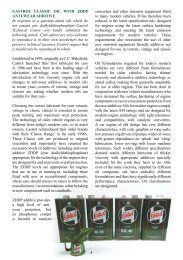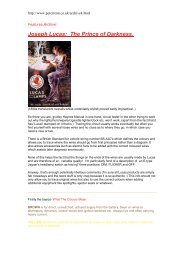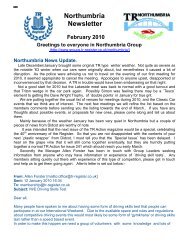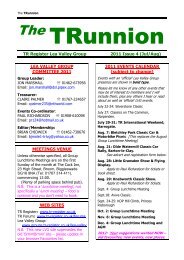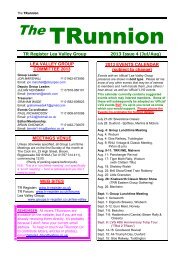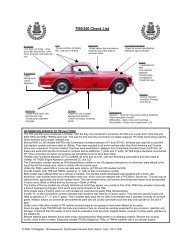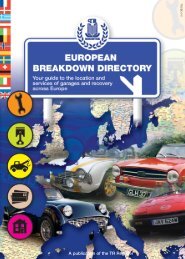TR4 Buyers Guide - TR Register
TR4 Buyers Guide - TR Register
TR4 Buyers Guide - TR Register
You also want an ePaper? Increase the reach of your titles
YUMPU automatically turns print PDFs into web optimized ePapers that Google loves.
BUYER BEWARE<br />
<strong>TR</strong> <strong>Register</strong><br />
1B Hawksworth<br />
Southmead Industrial Park<br />
Didcot, Oxon.<br />
OX11 7HR<br />
Tel: 01235-818866<br />
Fax: 01235-818867<br />
E-mail: office@tr-register.co.uk<br />
The most common enquiry received by the <strong>TR</strong> <strong>Register</strong> is “I’m thinking of buying a <strong>TR</strong>, what should I look<br />
for?” With this in mind a series of Buyer Beware guides has been produced to cover each of the series of<br />
Triumph <strong>TR</strong> sports cars.<br />
Basic rules for searching for a sound example apply to all models. Like most cars, all <strong>TR</strong>’s rust and over the<br />
years many have been partially or totally rebuilt with varying levels of competence. It is fairly easy to see or<br />
feel the weaknesses of a <strong>TR</strong>. Look along each side of a car for panel alignment, ripples and dents. Examine<br />
the whole length of the tops of the wings, where corrosion from beneath is common.<br />
<strong>TR</strong> doors are hung between “A” and “B” posts. Open the doors and check the condition of these. While the<br />
doors are open also check the edges of the wings. Then, with care (rusty edges can be sharp), feel along the<br />
bottoms of the wings and along the sills, beneath the doors. Check the bottoms of the doors, both visually<br />
from the outside but also by feel underneath. Check the edges of the bonnet and boot panels, both externally<br />
and with them open.<br />
Whilst the boot lid is open check carefully along the top edge of where the wing joins the body. A torch will be<br />
essential for this! Likewise, with the bonnet open check the inner panels carefully, especially at the top where<br />
they join the outer wings and around the front, near the headlights and bumper mounts. Leaking windscreen<br />
washer bottles can cause damage in an unexpected area. So check carefully beneath the bottle. Brake fluid<br />
and battery acid strip paint and cause corrosion of the metal beneath. Check these areas not only for signs<br />
of corrosion but also for any welds that appear non-original. All these areas should be finished in the same<br />
colour as the exterior of the body. A different colour, black, under-seal or anything else is not correct.<br />
The <strong>TR</strong>2-6 were built on a very strong chassis, although the chassis used up to and including the <strong><strong>TR</strong>4</strong> were<br />
the strongest. They should all be checked for corrosion, as well as distortion (through impact damage) and<br />
poor repair. There should be no unusual welds or patches.<br />
As a rule the front half of the chassis is protected from corrosion by oil leaks, but it is most prone to impact<br />
damage. The rear half should be thoroughly checked for corrosion, with the 6 cylinder cars appearing to<br />
suffer more than the <strong><strong>TR</strong>4</strong>A.<br />
The <strong>TR</strong>7, introduced in 1975, is completely different in body shape, engineering and mechanics to the earlier<br />
<strong>TR</strong>’s. Initially produced only as a fixed head coupe, whereas the others were open sports cars, it is of<br />
monocoque construction (no separate chassis) and with an engine developed for the Triumph Dolomite.<br />
Front suspension is by McPherson strut whilst rear is by beam axle.<br />
Throughout the whole life of the <strong>TR</strong> series by far the main market was the USA. Many cars have since been<br />
re-imported and this remains a regular activity. <strong>Buyers</strong> should be aware that not all US cars spent their entire<br />
life in ‘dry’ States and that corrosion on US cars can be just as severe as found on any home market cars. In<br />
addition, all US cars were originally LHD so it is important to ascertain the original specification of any car<br />
and verify the quality of any conversion work. Converted cars tend to have a slightly lower value than original<br />
RHD vehicles.<br />
<strong>TR</strong>’s originate from an era prior to VIN’s (Vehicle Identification Numbers) and used a number identified as the<br />
Commission Number. It is this number that should be found on an aluminium plate affixed to the car and<br />
detailed in the V5 under ‘VIN’. Ensure the numbers are the same then, if possible, armed with Registration,<br />
Engine and Body numbers contact the relevant Registrar for that model for advice on authentication.<br />
Whilst the text overleaf gives more information specific to a particular model of <strong>TR</strong> this document is intended<br />
only as a guide to the <strong>TR</strong> buyer. It is not a comprehensive, definitive, ‘checklist’. Would be purchasers who<br />
feel unqualified to assess the condition of a vehicle are advised to retain the services of someone capable of<br />
such an assessment.<br />
BUYER BEWARE!



